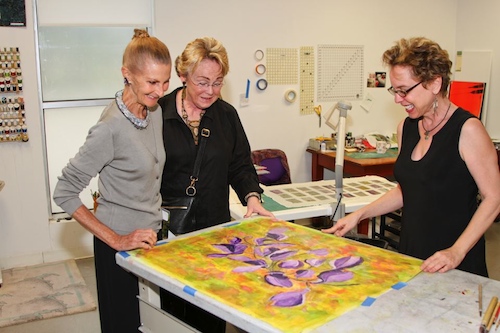
This week, we interviewed Susan Fletcher King, a Houston-based fiber artist who mixes quilted imagery with additional media, such as paint, dyes, specialty threads and embellishments. Susan graduated from the High School for the Performing and Visual Arts in Houston and earned a BFA from the University of Houston. She will be at HCCC through the end of December and will return to complete a second term of residency in the summer of 2013.
First off, can you tell us a little bit about what you are making? What inspired you to start creating fiber works?
The short answer is that I make quilts. I try to adhere to the accepted definition of what a quilt is: three layers, sewn together. Beyond that, my work is a combination of techniques that combine quilting with other art processes and media. Although my main love is fabric, I will often combine the fabric with other elements and embellishments to enhance the finished product. Ultimately, my quilts become wall hangings and will be two or even three dimensional. My love of fabric has always been there. But – not until I saw the fabulous Indonesian Batiks did I really figure out that here was something that resonated very deeply within me.
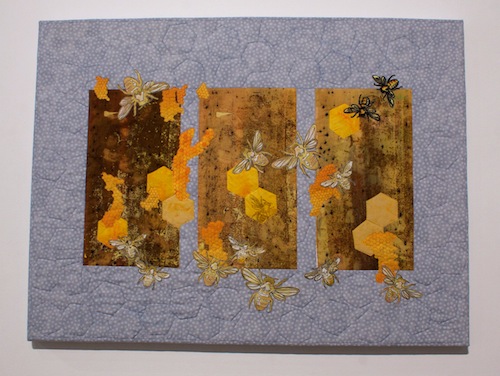
Can you describe the deconstructed screen-printing process? How does it currently fit into your work?
Deconstructed screen printing is a wonderful, often serendipitous process. Thickened dye is applied onto a silkscreen. After the dye has dried, the screen is used for printing. The dried dye on the screen gradually breaks down, resulting in continually changing prints. Depending on what I want to achieve, these prints may be stand-alone art pieces, or serve as the foundation fabric for other works.
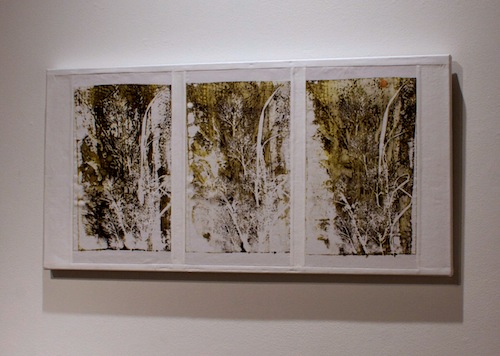
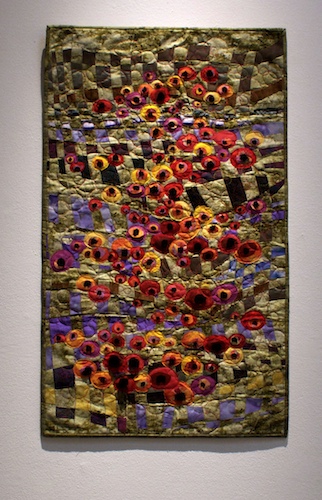
What is Batik?
Batik is both an art and a craft. Batik is a cloth that is traditionally made using a manual wax-resist dyeing technique.
How has the HCCC studio allow you to experiment with this?
The HCCC studio is a perfect place for me to experiment with this process since I am using my space as a “wet” studio. Batik is a slow and multi-step process, and I may have several pieces in various stages of dyeing, waxing or drying, and the studio allows me the room and ability to do this.
During a staff studio visit, you spoke about your early career as a graphic designer and the interesting array of life experiences you’ve acquired since. Can you share a few with us, and how does your past currently influence your work?
What immediately comes to mind is the fact that in direct contrast with being raised as a true “city girl,” I ended up working at a dairy, milking cows, training horses for the Egyptian Olympic Equestrian team, and even as a cook for a short time. Besides that, I have also held “city jobs” working in risk management for Hermann Hospital and Coca Cola Enterprises. Even though I took a long break from making conscious art, I found that art is indeed in all of us. I truly celebrate the differences that each of us has and the unique qualities that make us all individuals. For some of these life experiences, I was running away from my art background and thought I didn’t want art in my life anymore. I found out that there is always room for art, and art makes one happy and whole and healthy. More than any drug or medicine, art is restorative and best of all – all around us!
You and the other current resident artists recently had a pop-up show at 4411 Montrose. It seems to have been quite a success. What was the most elating part of this experience for you?
For me, the pop-up show confirmed that we five residents can “work and play well together.” Each of us brings something very different to our chosen craft, and yet the overwhelming consensus was that the pop-up show was cohesive, and our work complimented each other’s.

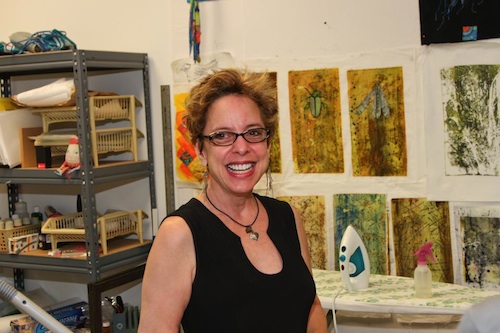
Your residency will be ending at the end of December, but you’ll be back for a second term in the summer of 2013. What are you going to be doing while you’re away from us, and how will this affect your work?
I will be working on commitments for various invitational shows and exhibits that need to be completed within the next 3-5 months.
Who was your biggest influence artistically?
Living artist – Velda Newman; dead artist- Hundertwasser.
As a Houstonian, what are your thoughts on our art community? What are some of the noticeable changes since your time at the University of Houston?
The biggest change that I see is that Houston is rapidly gaining stature and recognition in the larger art community. I believe that people are becoming more educated and gaining more awareness about what art is, and, likewise, what the Houston art scene offers.

